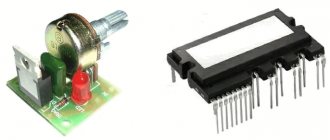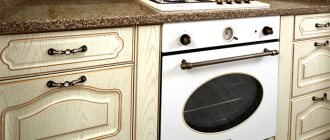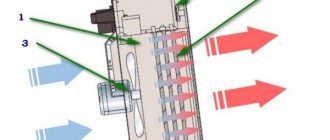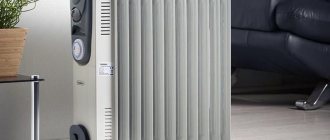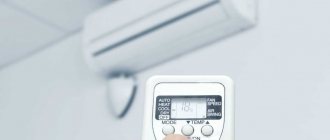Good day! As one wise man said, winter is coming. This means it’s time to consider one of the insulation options, for example, a convector heater - the pros and cons of which I have literally laid out on the shelves.
Last year, a neighbor purchased an electric fireplace on sale. In principle, he was happy until his allergies worsened in the middle of winter. Those who suffer from this disease know that attacks usually occur in spring and autumn. The neighbor did not immediately realize that the problem might be in the convector. Or rather, its unreasonable exploitation. My article is to help everyone who wants to heat their home without harm to their health.
How does this happen
We know what convection is from a high school course. Well, for those who are more interested in the humanities, let me remind you: convectiō is the “transfer” of layers of air of different temperatures from bottom to top. Convection can be natural - it occurs spontaneously, when a substance is unevenly heated - or forced, when warm air separates from the cold air and rises.
The principle of operation of convector heaters is the forced circulation of air masses. With constant movement, they mix, and the room becomes warmer.
The main element of such a device is the heat exchanger located at the bottom. Cold air, falling on the heating element, is distributed through special metal tubes and heated air is discharged outside.
The main advantage of such a heating system is speed and safety.
Varieties
The operation of the heater is based on the principle of natural air convection: cold air masses fall down and enter the lower grille of the device, pass through the heating element, heat up to the desired temperature, and then freely rise upward, thus spreading throughout the entire room. Air moves naturally, so no fan is required.
There are two types of convector heaters. Based on the type of energy, a distinction is made between electric and gas. In the first case, the energy source is electricity. This type of heater is the most common and popular due to its ease of installation, high heating speed and silent operation. You can choose a wall or floor option. The wall-mounted one takes up less space, but the floor-mounted one is more mobile and can be moved from room to room when necessary. The disadvantages of electric convectors include significant energy consumption, therefore they are most often used as an additional, rather than the main, source of heat. Gas convectors are more economical, however, this design requires a chimney.
Types of convector radiators
To better imagine how a convector works, it is worth knowing that it comes in three types:
- Electric.
- Water.
- Gas.
The most popular are electric fireplaces with convector radiators. They can be stationary (wall-mounted) or mobile (floor-mounted, on wheels). But, often, this is one type of heater - remove the wheels and you can hang it anywhere.
In the devices under consideration, heating elements can be a heating element (tubular electric heater), an incandescent filament or a nichrome spiral. The first option is the most environmentally friendly and safe. Firstly, the spiral is hidden by a metal pipe, which prevents the body from heating up. Secondly, the hidden heater reduces the possibility of fire to zero. Therefore, convector-type electric fireplaces with heating elements are allowed for use in government institutions.
I do not recommend using outdated models of devices with an open spiral. They not only dry out the air, but also mercilessly burn out oxygen. Dust settling on the coil burns and stinks. Even worse, the use of such devices increases the risk of fire significantly.
Gas equipment
The difference between a gas convector and an electric heater lies not in the operation of the unit, but in its installation and the cost of consumables (gas/electricity). If the house is connected to central heating, you only need to connect the device with a special hose. Such work should only be trusted to professionals. Among other things, you may need permission from the city authorities for an individual connection + installation of a meter.
Problems arise where there is no gas main. For example, outside the city - in private houses or holiday villages.
Then two options:
- Connect to the highway.
- Use liquefied gas.
The first is not cheap, but will pay for itself over time. The second option is to add fixed costs. So I advise, if there is no real possibility of connecting to the gas mains, switch to electric heating.
Another nuance is that gas convectors require an additional air supply and a pipe for removing combustion products. In apartments, the price of installing such a heating system will undoubtedly increase, since a project approved by the utility company is required.
Water system
The prerogative of using water as a heating element is still reserved to central heating suppliers. Without their permission and assistance, you will not be able to install a water convector at home. First, you need to have a working central office. Secondly, this type of heating will only be an addition. I only see the point in this in very cold regions where there is not enough power from the apartment pipes.
Advantages of convector radiators
Different types of devices have both common advantages and different advantages.
Advantages that all types have:
- Safety – it is impossible to get burned on the body of any type of unit. Fire is also ruled out.
- Electric, gas, water devices - they all have additional functions, depending on the model.
- The simplest control system.
- Possibility of remote control.
- Accessible to the majority of the population.
- With proper design, there is a good return on investment.
- Reliability – a convector system can heat an apartment for many years.
- Easy to install - no major repairs or layout changes required. The convector can be connected at any time of the year at the height of the heating season (exceptions are gas appliances).
- The presence of a thermostat makes it easy to regulate the temperature.
If we take each type of convector separately, the table of advantages will look like this.
| Electrical | Gas | Mermen |
| Affordable price | Fast payback | Saving on electricity |
| Quiet operation | Safety | Compactness |
| High efficiency (up to 95%) | Effective in cold weather and over large areas | Creating a thermal curtain between the window and the room |
| Heating rate | Durability | Variety of installation |
Additional options
The versatility of some modern models is one of the advantages of convector heaters.
Some features are very useful.
- Availability of a built-in fan. Accelerates heating of the room, allowing you to save on electricity.
- Ionizer. Creates a useful indoor microclimate.
- Humidifier. To maintain normal humidity.
- Possibility of individual settings. Some models of convector heaters are equipped with electronic controls. On the panel you can set the temperature mode for each day of the week (if required); regulate the frequency of switching on/off; monitor air dryness. An interesting feature for those who often leave, but do not want the house to freeze in the cold. In addition, proper settings help save electricity.
- Child lock function.
- Auto shut off option if dropped.
- Frost protection. Mostly it happens with electric fireplaces. They simply turn off when the ambient temperature drops to +5 degrees.
As you can see, such convectors have many advantages, which makes them a full-fledged heating system.
The best heaters
Next, we will describe several popular wall and floor models of convector heaters. We will pay special attention to their technical characteristics, advantages and disadvantages, which are taken from real consumer reviews.
Wall mounted
The Ballu BEC/EZER-1500 heater with two-level power control and built-in display effectively warms a room up to 20 m2. Such a device has a turn-on timer and built-in tip-over protection. If necessary, the manufacturer can include in the delivery set special wheels for operating the convector on the floor.
Convector heater Ballu BEC/EZER-1500 with wheels included
The main advantages of Ballu BEC/EZER-1500 are silent operation, quick heating of the room, convenient control, and affordable cost. Disadvantages: clicks of the regulator, hard buttons, inability to warm up the room above 20 degrees Celsius. There are defects: incorrect assembly of the heating element. The price of the model is 2500 rubles.
The wall-mounted convector heater Stiebel Eltron CNS 150 S was highly appreciated by consumers. This device operates from a heating element with a power of 1.5 kW, its operation is controlled manually. There is a thermostat on the moisture-resistant case. The heater is equipped with protection against overheating and the influence of negative temperatures. Cost 6330 rubles
The main advantages of this convector include: silent operation, muffled clicks of the regulator relay, high speed of heating the room. No deficiencies found.
Stiebel Eltron CNS 150 S
Another model of the Timberk TEC.E3 M 2000 is designed for heating rooms with an area of 24 m2. This device operates from a 220-volt power supply; there is three-level power control by turning on several heating elements of 2, 1.15 and 0.85 watts. The convector has a moisture-proof housing and weighs 5.3 kilograms.
The advantages of Timberk TEC.E3 M 2000 are its affordable price of 2912 rubles, low electricity consumption, the ability to quickly warm up the room, and silent operation. Disadvantages: short cable, poor build quality, heater dries out the air.
Timberk TEC.E3 M 2000
Heater Ballu BEP/EXT -1000 with three-level power control. This small-sized device weighs only 5.8 kilograms and is protected against overheating and exposure to negative temperatures. The convector is designed for heating small rooms with an area of 15 m2. The cost of the unit is 3300 rubles.
The main advantages of Ballu BEP/EXT -1000 are: remote control of the device, small dimensions, functionality, quick heating of the room. Some buyers point out one drawback of this model - the creation of low temperatures in the room.
Ballu BEP/EXT -1000
Flaws
The Achilles heel of convector heaters is their high electricity consumption. There are economical models, but utility costs will still increase in winter.
Here are some more disadvantages that cannot be ignored:
- Convectors dry the air. It doesn’t matter what kind of device you have - electric, gas, water - the very principle of operation is to extract moisture from the atmosphere.
- Low efficiency in large rooms with high ceilings. This applies to water appliances and electric fireplaces. If there are no interior doors and poor thermal insulation, do not expect a convector heating system to replace the central heating system. The exception is gas radiators, but they also have their drawbacks.
- For example, their installation will take time and require the intervention of professionals and local authorities. And blue fuel is not cheap these days, so you can’t count on much savings.
- In the absence of a built-in fan, the air masses are mixed unevenly. As a result, drafts may occur.
- Water convectors work effectively only as additional heating. For example, if you need to balance the temperature in your home. When the problem is a draft from a window, hang the unit nearby - it will create a thermal barrier. If you want to dry a corner room, use the built-in water convector. Also, such devices can simply be floor-standing.
As you can see, some disadvantages can be covered by advantages. But any technology has disadvantages, even luxury ones. The main thing is that the device is safe for health.
Difference between convection heater and radiator
The heating system only reminds itself with the arrival of cold weather. However, you need to prepare the sled in the summer. During the cold season, comfort indoors, be it a house, apartment or office, is vital. Heat supply is a serious issue, especially in the choice of radiators.
Designation
A heating device is a radiator in the middle of which a coolant (water, antifreeze) moves. The heating device returns heat to the room using infrared, in other words thermal, radiation. Heating of the room occurs from the window into the room. According to their design, heating devices are sectional, tubular and panel. The level of heating of the room depends on the number of attached sections or panels. Today, our usual cast iron sectional heating devices are being replaced with metal or bimetallic devices.
The material from which the radiator is made plays an important role in heat transfer
Heating device
The radiator design is a radiator that transfers heat using convection. Convection is a physical phenomenon in which air flows through the heater, increases in volume and enters the space of the room, while cooler air occupies the free space. Air circulation occurs in a real way, creating a temperature difference. In the design of a convector heater, the important elements are: a channel through which the coolant moves, and grates or plates through which air passes.
Radiator design to contents ^
When comparing heating devices and convector heaters, let’s turn our attention to the places of their use. So, for example, water heating radiators are perfect for office and industrial premises with an increased glazing area, and also with a very high level of moisture (greenhouses, semi-houses, semi-gardens, swimming pools)
Panel radiators made of steel are very often installed in cottages and cottages. To heat apartments in houses with centralized heating, today it is proposed to install bimetal radiators.
It is believed that in terms of heat output, heating devices give off more heat than convector heaters. This is due to the surface area, which is involved in the heat transfer process. Heating devices provide more constant heating of the air, and convector heaters can create a draft in the room. This phenomenon occurs due to the movement of air from bottom to top. And if the device does not cover the width of the window, then the air also moves from the window into the room. From a safety point of view, convector heaters are considered less hot than, say, a cast iron radiator. But due to the properties of the structure, dust collects in the design radiators.
Conclusions TheDifference.ru
- The heating device has a very high heat output;
- The heating device is more economical to operate; the radiator design requires more heat input;
- A heating device will cost much more than a radiator design;
- The heating device is more environmentally friendly, the design of the radiator collects and drives away dust;
- The heating device is more powerful and larger; the radiator design is more compact and can be built into walls and floors.
Is the devil as scary as he is painted?
Don't think I forgot about my allergic neighbor. When he came to me with a question whether an electric convector is harmful, I could not answer unequivocally. Firstly, professional ethics does not allow it - after all, I am not a doctor. Secondly, people often hear only the part of the phrase they want. Thirdly, there is nothing unambiguous in the world and what is good for one is death for another.
Judging by the reviews, it is people with respiratory tract diseases who suffer from convector radiators. Devices dry out the air, increasing its allergenicity. The situation is aggravated by the fact that many consumers do not know what ventilation is in the cold season. And if you have pets and are very lazy, convectors can turn the life of allergy sufferers into hell. It will also be hard for asthmatics living in a small apartment: stale, heated, dry air does not promote free breathing. Reading reviews, I found that 90% of consumers often have headaches and drowsiness in winter. If you recognize yourself and are guilty of using an electric fireplace, but cannot give it up, I suggest taking your health into your own hands.
- Ventilate your home regularly. Yes, yes, even at minus 20 Celsius. Ten minutes will not make you sick; on the contrary, fresh air will be beneficial to your body.
- Install additional humidifiers, place bowls of water in the corners, and at least spray the room with a spray bottle every hour - take control of air humidity.
- Don't be lazy to clean more often. It just seems that in winter, when the windows are closed, dust does not collect. It simply does not settle, because the turned on convector prevents it from doing so.
In general, when operating electric heating devices, do not abdicate responsibility for your own health. Be healthy and visit my blog more often!
By the way, here is an article where I compare convector and oil heaters. And here is a comparison of convectors and infrared heaters.
Thank you for your attention! Sincerely, Rostislav Kuzmin.
Advantages and disadvantages
Electric convectors have enough advantages. Its first and most important advantage is high efficiency; the convector provides this indicator at 95%.
POPULAR WITH READERS: How to connect an electric stove at home yourself
In addition, positive qualities also include:
- Easy to install and use. All you need to do is place it next to the outlet, connect it to it and set the temperature;
- The design of such a convector is very simple, which ensures high reliability. The average service life of a convector is approximately 15 years. At the same time, it requires minimal maintenance - periodic cleaning of the device from dust;
- The presence of a thermostat in the design ensures automatic maintenance of the temperature in the room, without human intervention. When the desired temperature in the room is reached, it turns off. As soon as the temperature drops, the convector turns on. Moreover, the convector is guided by the temperature in the lower part of the room, that is, by the cold air. Therefore, the temperature sensor is located at the bottom of the convector;
- The design of such a convector has no moving parts, which ensures silent operation. The only source of noise can be a thermostat, made in the form of a mechanical relay. When activated, such a thermostat will create a clicking sound when the contacts close. Electronic thermostats do not make any sounds;
- These heating devices begin to provide heat to the room almost immediately after being plugged in, and are able to quickly heat the air in the room;
- Safety of use. Even at maximum performance, the heater body, which also participates in heat exchange, does not heat up to such a temperature that can cause a burn to a person. A fuse protects the device from overheating.
Flaws.
However, convector heaters also have disadvantages. Although they are few and far between, they exist.
So, the disadvantages of convectors include:
- Significant energy consumption. Although this indicator largely depends on the thermal insulation of the room. With strong heat losses due to drafts, poor insulation of walls and windows, energy consumption will be high, but if thermal insulation is at the proper level, energy consumption will not be particularly high;
- It will not be economically feasible to heat large rooms with convectors. They are more suitable for local heating. That is, they are best used either in small rooms or as a supplement to centralized heating;
- Convector heaters, although they do not heat the air to significant temperatures, still dry it out somewhat. Therefore, when using such devices, it is better to worry about air humidification in advance;
- Even without moving parts, the convector is capable of spreading dust throughout the room. It does this because the air circulates during its operation due to heating, and therefore moves small dust particles.
We recommend reading - how to choose electric heating boilers.
